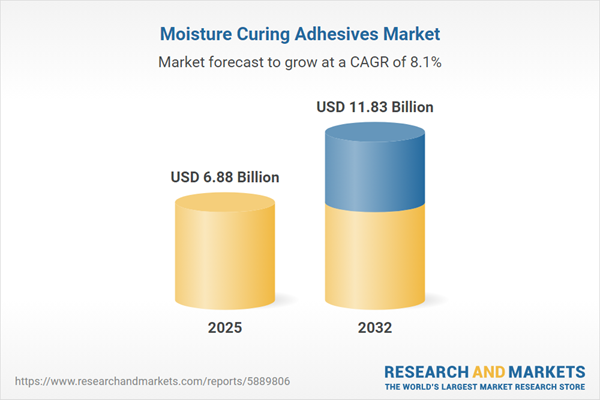Speak directly to the analyst to clarify any post sales queries you may have.
The moisture curing adhesives market is transforming modern manufacturing with dependable, efficient solutions suitable for multifaceted industrial applications. Strategic investment, shifting sustainability regulations, and digital innovation are shaping future growth and resilience across the global sector.
Market Snapshot: Global Growth for Moisture Curing Adhesives
The moisture curing adhesives market grew from USD 6.36 billion in 2024 to USD 6.88 billion in 2025. It is expected to continue growing at a CAGR of 8.06%, reaching USD 11.83 billion by 2032. This robust performance highlights expanding demand across automotive, construction, and electronics manufacturing, as companies prioritize operational efficiency and product innovation.
Scope & Segmentation of the Moisture Curing Adhesives Market
The market is analyzed through distinctive lenses to ensure a holistic understanding:
- Product Types: One-component adhesives; two-component adhesives.
- Form Options: Liquid adhesives; paste adhesives.
- Technology Platforms: Polyether systems; polyurethane systems; silane terminated polymer systems.
- Packaging Types: Bottles and cans; bulk containers; cartridges designed for precision dispensing.
- Viscosity Levels: High viscosity; medium viscosity; low viscosity - each suited to specific application and production needs.
- End Use Industries: Automotive and transportation; building and construction; electronics and electrical; furniture and woodworking; packaging.
- Regional Markets: Americas (United States, Canada, Mexico, Brazil, Argentina, Chile, Colombia, Peru); Europe, Middle East & Africa (multiple countries across Western and Eastern Europe, Gulf Cooperation Council, and Africa); Asia-Pacific (China, India, Japan, Australia, South Korea, Indonesia, Thailand, Malaysia, Singapore, Taiwan).
Key Takeaways for Senior Decision-Makers
- Moisture curing adhesives enable strong, versatile bonds across metals, plastics, and composites, accommodating the growing trend toward multi-material integration in manufacturing.
- Solvent-free curing delivers compliance with strict environmental standards without sacrificing adhesion, supporting corporate sustainability initiatives.
- Digital transformation — such as the adoption of inline rheology sensors and connected curing ovens — enhances quality assurance and process efficiency in high-throughput production environments.
- Product customization evolves with emerging application needs, enabling tailored formulations for thermal resistance, flexibility, and rapid strength gain in demanding sectors.
- Sustained R&D investments and collaboration between chemical suppliers and equipment manufacturers drive technology advancements, reinforcing service life and competitive differentiation.
- Regional strategies, including nearshoring and harmonized regulations, allow companies to optimize procurement and streamline approval cycles.
Tariff Impact: Strategic Adjustments Amid Raw Material Disruptions
Tariff measures imposed in 2025 on key raw materials such as isocyanates and silane coupling agents prompted adhesive manufacturers to reevaluate sourcing and pricing strategies. Leading companies mitigated cost increases by turning to alternative local suppliers and reengineering formulations for improved yield. Enhanced supplier agreements and new monomer blends improved resilience and laid the foundation for continuous improvement in supply chain and risk management.
Methodology & Data Sources
This report draws on a robust, multi-stage research approach combining in-depth interviews with senior technical and procurement leaders, analysis of public filings, technical reports, and industry association documents. Insights are validated through literature reviews, patent data, and expert synthesis workshops, providing a complete and current perspective on global market trends.
Why This Report Matters
- Senior stakeholders gain actionable insights for risk management, cost efficiency, and innovation strategy amid evolving regulatory and supply chain challenges.
- The report supports informed investment decisions by mapping market segmentation, technology adoption, and regional growth patterns.
- Benchmark competitor strategies, uncover partnership opportunities, and assess R&D focus to stay ahead of industry transformation.
Conclusion
Moisture curing adhesives stand at the intersection of sustainability, advanced manufacturing, and resilient supply chains. Senior leaders can leverage these insights to drive sustainable growth, operational agility, and long-term value across a dynamic global market.
Additional Product Information:
- Purchase of this report includes 1 year online access with quarterly updates.
- This report can be updated on request. Please contact our Customer Experience team using the Ask a Question widget on our website.
Table of Contents
3. Executive Summary
4. Market Overview
7. Cumulative Impact of Artificial Intelligence 2025
Companies Mentioned
The companies profiled in this Moisture Curing Adhesives market report include:- Henkel AG & Co. KGaA
- 3M Company
- H.B. Fuller Company
- Sika AG
- Dow Inc.
- Bostik S.A.
- Soudal N.V.
- Shin-Etsu Chemical Co., Ltd.
- Wacker Chemie AG
- Huntsman International LLC
Table Information
| Report Attribute | Details |
|---|---|
| No. of Pages | 188 |
| Published | October 2025 |
| Forecast Period | 2025 - 2032 |
| Estimated Market Value ( USD | $ 6.88 Billion |
| Forecasted Market Value ( USD | $ 11.83 Billion |
| Compound Annual Growth Rate | 8.0% |
| Regions Covered | Global |
| No. of Companies Mentioned | 11 |









